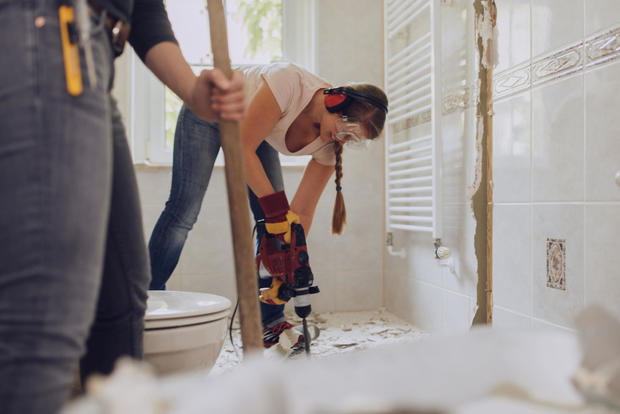Getty Images
As winter fades and a new season begins, you may have more on your mind than spring cleaning; You may be looking for more of a home refresh.
This can take the form of home improvement, home repair and/or reform. Doing so can help you enjoy your space more and potentially increase your home’s value.
Depending on the type of project and your local real estate market, you may be able to recoup most, if not all, of your investment. Sometimes you can even increase the value of your home by more than what you spend on projects, in terms of time savings and overall appeal you can provide to the next buyer. For example, $3,600 in curb upgrades, such as yard care, returns about $14,800 in resale value, according to Homelight.
But what if you don’t have the cash for those home improvements, especially more expensive upgrades, like a bathroom or kitchen remodel?
Some homeowners find that tapping into their home equity gives them the flexibility they’re looking for to make home improvements. Although you’ll want to weigh factors like the cost of financing and the risk of not being able to afford the loan repayments, you may find that taking out a loan against your home equity makes sense for your situation.
You can now easily explore your home equity loan options online to see how much you qualify for.
How to Pay for Home Improvements
Here are two options for homeowners with equity in their home to help pay for home improvements.
HELOCs
A home equity line of credit (HELOC) A revolving line of credit that you can draw on over time rather than all at once. In that sense, a HELOC is like a credit card, where you don’t have to borrow up to your full credit limit, but you do have that option. And your credit limit will refresh as soon as you pay off your balance.
Meanwhile, HELOC interest rates are much lower than credit card rates. HELOCs March 2023 tends to be somewhere in the 7-8% ballpark; Credit card rates average around 20%, and personal loans around 11%, respectively Federal Reserve. So, if you want to borrow money for home improvements, a HELOC may be more affordable.
And unlike some other types of loans, such as a personal loan, of a HELOC Structure means you can space out your borrowing. Perhaps you want several thousand dollars in cash to decorate your backyard to enjoy during spring and summer. Then, you’ll want to draw from your HELOC again before next winter to refinish your floors as you prepare to spend more time indoors again.
And if you end up needing money unexpectedly, like when a kitchen appliance breaks and you don’t have a home warranty policy, you may be able to get that money from your HELOC.
Check out your local HELOC options here now
Home equity loan
Another option to consider is a Home equity loan, often called a second mortgage. This type of financing gives you a lump sum loan based on your home equity, and unlike a HELOC, it has a fixed interest rate.
Home equity loan The average interest rate until March 2023 is around 8%. So, while it may be a little higher than some HELOCs, you also don’t have to worry about interest rate increases, which can make the HELOC more expensive to repay.
In other words, if you want more security about what your monthly payments will be when you pay back what you borrowed, you may prefer a home equity loan. Because the funds come as a lump sum, you can use a home equity loan for larger projects, such as redoing your kitchen or adding an addition to your home.
You can easily check your home equity loan options online today.
Bottom line
Both HELOCs and home equity loans allow you to borrow up to 85% of your home’s combined loan-to-value ratio, which generally means that your current mortgage debt and new financing can add up to 85% of your home’s appraised value.
Both carry risk in the sense that if you can’t pay what you borrow, the lender can foreclose on your home, so you’ll want to be responsible when taking on any equity.
Other types of home equity financing also exist, such as a cash-out refinance or reverse mortgage. A Cash-out refinancing It involves replacing your current mortgage with a new, larger one that gives you cash. But it’s not always convenient, such as for a homeowner who pays a lower mortgage interest rate on a fixed-rate mortgage, compared to what the market currently offers.
And reverse mortgage Available to senior home owners only. Reverse mortgages don’t have to be repaid until you no longer live in your home, but these loans can erode your home equity.
Instead, it may make sense to pay for home improvements with a home equity loan or HELOC. Shop around to see what your borrowing options are and compare the benefits you could get by making some upgrades to your home.


No Comments
Leave a comment Cancel